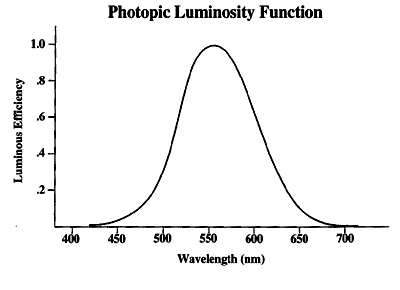Luminance, Illuminance, Lumens, Lux, . . .
Radiometry: the measurement of power produced by a source of electromagnetic radiation
Photometry: the effect of electromagnetic radiation on the visual system
Radiant Power: the energy per unit time (watts) released by a source of electromagnetic radiation
Luminous efficiency: for a given wavelength of electromagnetic radiation, its relative ability to induce a sensation of 'light'.
Photopic luminosity function: A plot of the luminous efficiency versus wavelength of radiation. It has long been recognized that the ability of the receptors in the retina to absorb electromagnetic radiation depends on the wave length of the radiation. Consequently, in 1924, the Commission de l'Eclairage (CIE) created a standard photopic luminosity function or 'standard observer' (see below) for photometric measurements. For the human eye, an efficiency of 1 was assigned to the wavelength of 555 nanometers (nm). The logarithm of this function is the 'relative visual brightness'.

Luminous power: for monochromatic radiation, its radiant power times 683 times the luminous efficiency. The unit of luminous power is the lumen. For a mixture of wavelengths the luminous power is the sum of the luminous powers for the individual wavelengths (Abney's Law of Additivity).
Lumen: by definition there are 683 lumens per watt of radiant power at a wavelength of 555 nm
Luminous intensity: the number of lumens produced per unit solid angle (in a given direction) by a point source of light. One lumen per steradian is one candela.
Candela:unit of luminous intensity; one lumen per steradian
Luminance: the number of candelas per unit surface area of an extended source. Here, 'surface area' refers to the projected area of the true surface, along the viewing direction.

Illuminance: the luminous power incident per unit area of a surface. One lumen per square meter is one lux. One lumen per square foot is one foot-candle.
Lux: an illuminance equal to one lumen per square meter
When comparing sources of light one is usually interested in their relative visual brightnesses. Since brightness is related to luminous power it is clear that one should be comparing their lumen ratings instead of their radiant powers in watts. A higher lumen rating always means a brighter light. A higher watt rating does not.
REFERENCES:
S. H. Schwartz, 'Visual Perception: A Clinical Orientation' (Appleton & Lange 1994), Chapter 4.
Jo Ann S. Kinney, 'Human Underwater Vision: Physiology and Physics',(Undersea Medical Society, Inc., 1985), Chapter 1.
Last Modified: 11:22pm , June 23, 1996


